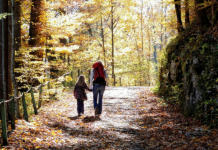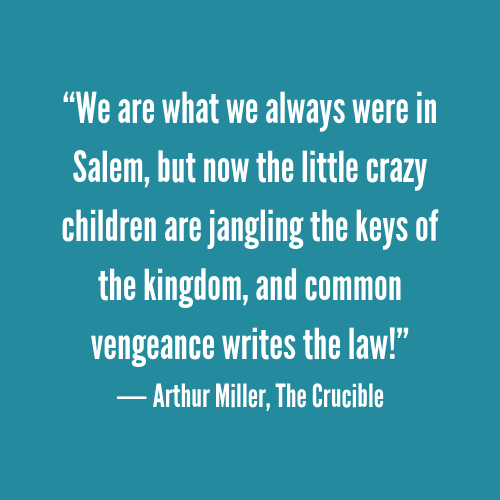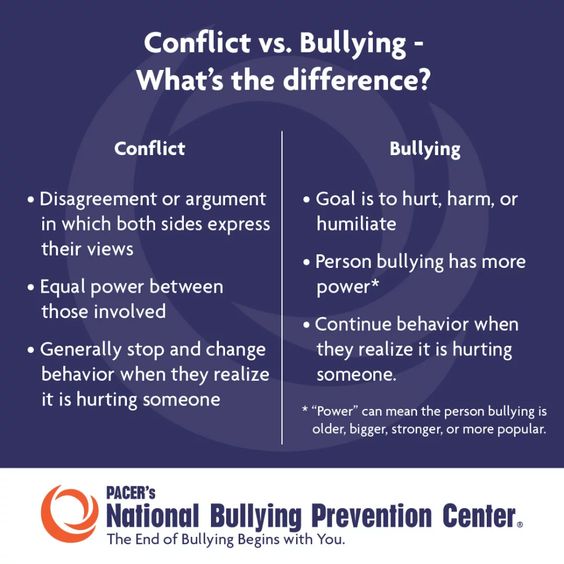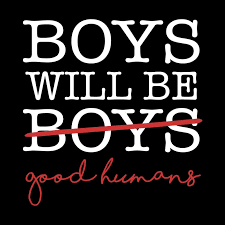The children line up at the front of the room in preparation for the daily march to the cafeteria for lunch. They are excited and eager to eat and socialize with their friends. In the middle of the line, a boy—tall for his age, is pushing a smaller boy in front of him, all while teasing and calling him names. The smaller boy is trying to ignore what’s happening and moves closer to the wall. Noticing the commotion, the teacher tells the two of them to settle down and quit the horseplay.
 The students are in assigned seats at their table in the cafeteria, the little boy who had been shoved in the lunch line is called to go to the parent lunch table because his mother is there to have lunch with him.
The students are in assigned seats at their table in the cafeteria, the little boy who had been shoved in the lunch line is called to go to the parent lunch table because his mother is there to have lunch with him.
Just as he stands in excitement to go to his mother, the taller boy shoves him hard in his back causing him to trip and bite into his bottom lip. Tears spill from his eyes as blood dribbles from his lip. His mother runs to him, pulling him up and scolds him, “Stop crying. It’s only a little cut. You’re a big, strong boy… boys don’t cry.”
Would you accuse the taller boy of being a bully? Does this smaller boy strike you as a victim? What roles do the parent and teacher play in this scenario? Are these incidents simple confrontations brought on by underlying conflict?
What is bullying?
According to the American Psychological Association, bullying is a form of aggressive behavior in which someone intentionally and repeatedly causes another person injury or discomfort. Bullying can take the form of physical contact, words, or more subtle actions.
It’s important to note that the Oxford dictionary has a similar, but different definition of the word. According to them, bullying is defined as seeking to harm, intimidate, or coerce someone or persons perceived as vulnerable.
Does it matter which definition is used when discussing the harmful effects of bullying? Yes, because one definition addresses the significant psychological impact on both the bully and victim; while the other simply defines the actions of the bully. For the purpose of this article, I’ll be using the definition provided by the APA.
It’s not enough to understand what constitutes bullying. If we are to combat this epidemic in our schools, we have to strive to understand why and then how. The APA’s definition provides a solid foundation upon which further exploration can be built.
What is the difference between bullying and confrontation/conflict?
In its basic form, conflict is a differing of opinions between two or more persons. All parties have the opportunity to participate equally in the argument.
Unfortunately, in the current anti-bullying climate within our schools, most don’t know how to differentiate between the two and the bully label is slapped on every confrontation, disagreement, and dispute.
As noted by Emily Bazelon in an article on the Psychology Today website, “… a wave of recent anti-bullying legislation includes at least 10 different definitions, sowing confusion among parents and educators. All the misdiagnosis of bullying is making the real but limited problem seem impossible to solve. If every act of aggression counts as bullying, how can we stop it? Down this road lies the old assumption that bullying is a rite of childhood passage. But that’s wrong.”
It’s being argued that the need to address the bullying issue has created an environment where children have no idea how to handle normal, everyday conflicts and/or confrontations. An environment where not being picked to play a game causes psychological damage. I’m reminded of Arthur Miller’s play, The Crucible.
How to tell the difference between conflict/confrontation and bullying?
Let’s look at the APA’s definition of bullying again.
- aggressive behavior
- intentionally and repeatedly
- injury or discomfort
- physical contact, words, or more subtle actions
I call these the four pillars of bullying. In order for conflict/confrontation to be considered bullying, all four of these pillars must be present. Having a common understanding of what constitutes a bullying situation is paramount to addressing the problem.
I want to go back to the scenario in the beginning of this article. Obviously, this is a case of bullying. If I were a writer… oh, wait—I am a writer. Oh well, I digress. It’s clear the taller boy is bullying the smaller one.
What’s not clear is what is being done about it.
This is where having a common definition of the term is important to protecting both the bully and the victim. Yes, the bully needs protection as well, but I’ll get to that in part two of the series. One of the more disturbing aspects of the bullying epidemic is the misinterpretation of what’s taking place because of social gender biases.
What is social gender bias?
In the scenario, the teacher told the boys to, “quit the horseplay.” Horseplay is an idiomatic expression meant to describe two or more persons engaging in rough and rowdy play. Why would the educator call what is clearly a case of bullying, rowdy play? Acceptance.
America has a culture of acceptance when it comes to violent behavior. Not just acceptance, but the expectation in many cases. I write adult contemporary romance, and my genre is notorious for creating male characters based on what the psychological community calls, harmful masculinity. We create them and our audiences eat them up because we have all bought into the more male-centered idea of what makes a man a man. Therefore, we may be socially blind to bullying because we associate certain violent attributes to boys being boys. Attributes, such as
- Dominance
- Competitive
- Toughness
- Seriousness
- Heterosexuality
- Self-sufficient
- Emotionally disconnected
In a recent Gillette advert, the company came under fire for challenging the status quo of masculinity. Men felt the ad was generalizing and stereotyping all men as Kim Elsesser, a Forbes contributor states, “[the advertisement]… suggests that most men engage in these behaviors. It follows that to fit in, or to be “masculine,” one would seek approval by engaging in those behaviors engaged in by a majority of the groups.”
I’m not going to debate the merits of the ad, but it’s interesting how when harmful masculinity is questioned, according to Forbes, ten to one of the men viewing the ad feel affronted. (feel free to click on the Gillette link to watch the ad, tell me what you think)
Back to the teacher in the first scenario. She assumes the boys are just being boys because of social gender bias. Is the teacher at fault for not paying attention and reading the situation correctly?
Yes and no. Yes, she’s at fault because she’s the adult in the room and honestly, there’s no room for biased assumptions in our schools. No, because she is a product of the same environment that created her bias in the first place. Without a clear definition of bullying and succinct plan of action regarding the act, how are educators supposed to retrain their brains to recognize when students are in trouble and not just… being boys?
It’s not enough to have an anti-bullying policy in place. It’s not enough to discipline the bully and placate the victims and their families. There has to be a change in basic thinking about how we define both the aggressive act and the aggressor. We have to create a common language for students, parents, and school personnel. Until we remove the lens of acceptance steeped in the old adage, boys will be boys—we are always going to foster a culture of bullying.
I’d love to hear from you. I know this is a touchy topic and many families are affected by bullying every day. Be sure to subscribe to my posts. I thought I’d be able to address everything I wanted to in one article, but it appears I have a lot more to say.
Join me next week, when I discuss what makes a person a bully, what makes a person a victim, and what they have in common.
If you or someone you know is being bullied or acting as a bully, please reach out and get the help they need.
Resources
- https://www.pacer.org/bullying/
- https://www.stopbullying.gov/laws/south-carolina/index.html
- https://www.sprc.org/states/south-carolina
Remember life is a journey, just because you’re wandering doesn’t mean you’re lost. Stay enchanted.

















